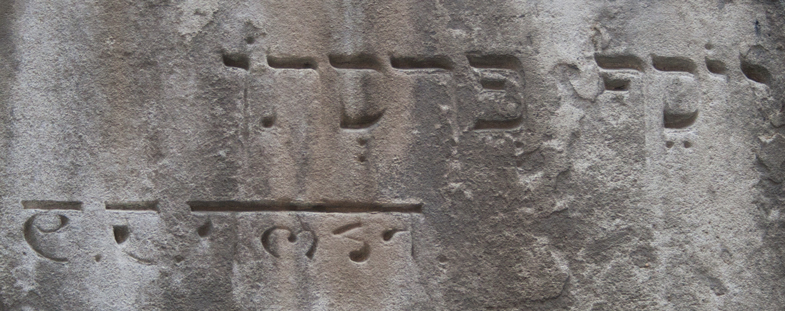One of the biggest struggles of the project has been interpreting the two names written in unfamiliar alphabets. The inscriptions, in Hebrew and Devanagari (an North Indian script) are together on the South Wall.
The Hebrew proved fairly easy to decipher and match to a former pupil. The first name is undoubtedly ‘Yosef’ with the obvious English equivalent of ‘Joseph’. The consonants of the surname read ‘P or F, S, T, N’. There is a vowel sign near the last syllable which means that the name probably ends in ‘ton’. We briefly thought the surname might be ‘Thurston’ as the ‘Th’ sound does not really exist in Hebrew and an ‘F’ sound could have been an innovative replacement. However, our Joseph Thurston was at the school in the early 18th Century and it seemed unlikely that a single name from a much earlier period would have survived. Taking a second look through the Old Westminsters named ‘Joseph’ (there were only 107 up until the end of the 19th Century!) we realised that the surname was probably ‘Preston’. Having made the suggestion one of our Hebrew readers noted ‘I can see that there is a (silent) ‘schwa’ under the first letter of the surname, which makes it clearly Pr at the beginning’. Preston’s clerical profession means that he may well have studied Hebrew whilst at the school.
PRESTON, JOSEPH, only son of Capt.Thomas Preston, Royal Navy, and his first wife Sophia, dau. of Joseph Clover ; b. 28 Dec 1826 ; adm. 11 Jan 1841 (G) ; rowed v.Eton 29 Jul 1845 ; Trinity Coll.Cambridge, adm.pens. 16 Jun 1845 ; 33rd Wrangler 1849 ; BA 1849 ; MA 1852 ; ordained deacon 1860, priest 1861 (both London) ; Curate, St.Michael’s, Chester Square, London 1860-2, Wymondham, Norfolk 1863-6, Reymerston, Norfolk 1866-74, St.Helen’s, Norwich 1875-82 ; m. 29 Jul 1862 Marian Anne, sister of William Graham Green (qv) ; d. 13 Feb 1900.
The Devanagari script name has proved rather more difficult. Jonathan Katz (former Master of the Queen’s Scholars) has provided invaluable help.
He first wrote:
‘In the Indian one, as we’re dealing with a name which may not even be Indian, it’s not possible for me to say what ‘language’ the inscription represents…But the two initials are E (but would be pronounced ‘ay’ as in ‘lane’ if this were read out as an Indian would read it) and R. So we may have A.R. rather than E.R. The surname appears to be something like ‘Galdan’. The vowels would both be pronounced like the ‘u’ of ‘butter’…There is a possibility that despite the very competent lettering, the wrong letters have been used, and the name might be something like Malden or Yelden. But as it stands that first letter is ‘g’.’
Now there is an OW with the surname ‘Goolden’ which appears a good fit. But his first name was ‘Charles’. Moreover he already features on the North Wall leading up school. Focusing this time on the initials and looking at pupils who were near contemporaries of Preston (as what we have is a clear example of one-upmanship!) we have settled on the following pupil as the best fit:
GLYN, EGERTON ROBERT, youngest son of Thomas Clayton Glyn (qv) ; b. 23 Jan 1827 ; adm. 5 Jul 1837 (G) ; QS 1841 ; rowed against Eton 1 Aug.1843 ; left 1844 ; at Haileybury Coll. 1845-6 ; Writer, EICS Bombay 1847 ; Third Assistant to Collector, Kaira 1848 ; Second Assistant to Collector, Surat 1849 ; d. at Bombay 8 Sep 1852.
Glyn’s later career working for the East India Company in Bombay supports this theory. However, as Jonathan Katz points out ‘it is really hard to see that penultimate letter as anything other than a d, actually a ‘cerebral’ or ‘retroflex’ d, which would be the normal way of representing an English d in an Indian script.’
Still, it’s the best solution we’ve got thus far. And as Jonathan has kindly suggested:
‘I suppose one could imagine a scenario in which Glyn had done some very elementary and misguided letter-searching and then instructed an otherwise innocent carver (or a superb imitator, perhaps working from a tracing, or …) to go ahead with a mistaken model.’
Further suggestions as to the former pupil behind the Devengari script name would be most welcome!
Update – 24/01/2018
A pupil has recently transcribed notes by Old Westminster, R.S. Chalk, reminiscing on his school days in the 1920s. Chalk asserts that he translated both names on the South Wall, the first as Joseph Preston and the second as E.R. Glyn. Chalk had learnt Hebrew whilst at the school and spent several years in India as a teacher and chaplain.
